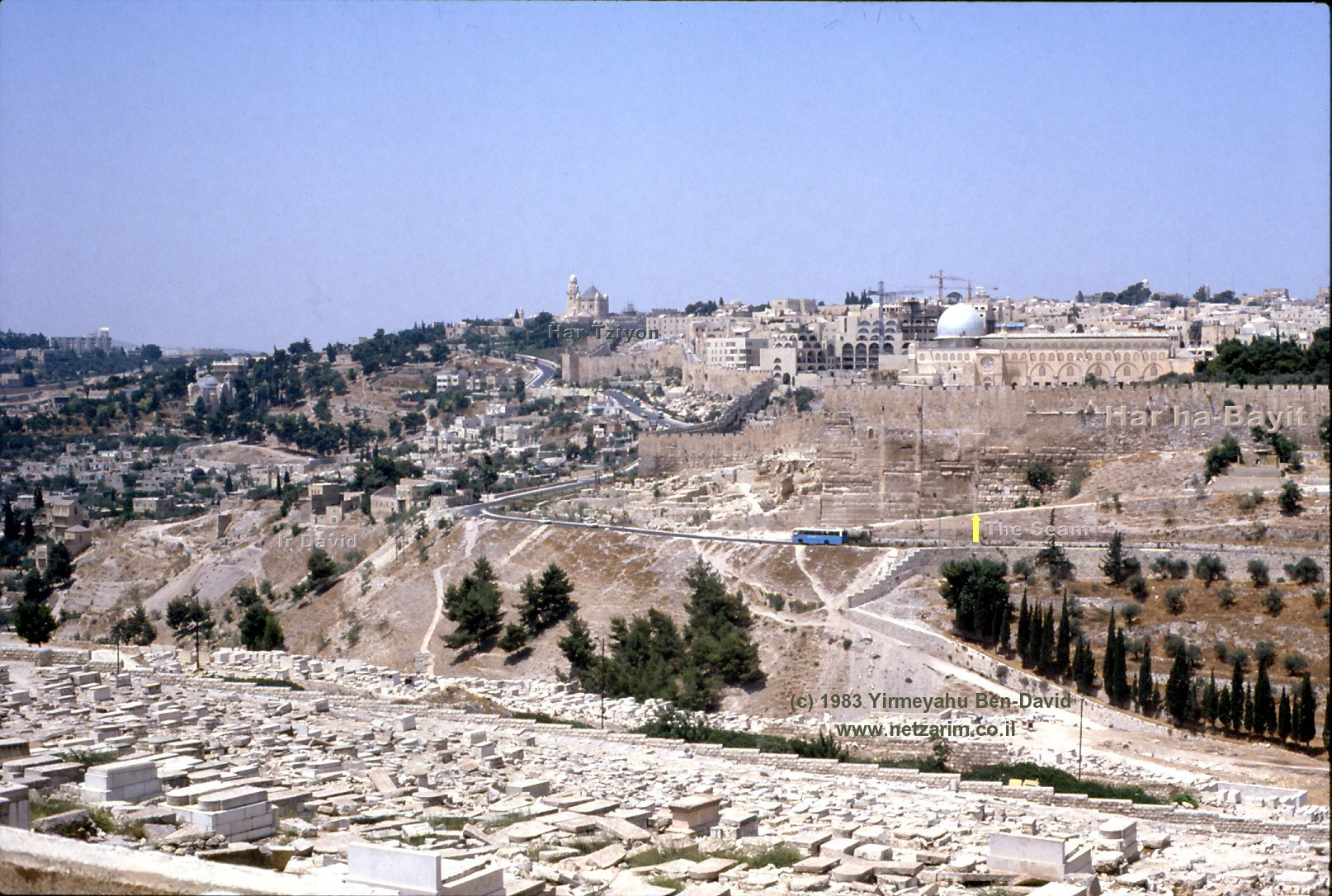
 |
[Updated: 2022.03.31]![]()
 |
| Yᵊru•shâ•layꞋim |
Yᵊru•shâ•layꞋim, corrupted, via Hellenist Greeks, to "Jerusalem."
Excerpted from "Jerusalem," Ency. Jud. (9.1379)—The first mention of the city of Yᵊru•shâ•layꞋim is in the Egyptian Execration Texts of the 19th-18th centuries B.C.E… probably pronounced 'rushalimum.' In the Tell el-Amarna letters of the 14th century B.C.E., it is written Urusalim, and in Assyrian Ursalimmu (Sennacherib inscription). In the Bible it is occasionally spelled יְרוּשְׁלֶם (Yᵊru•shᵊlëmꞋ)…
Before its conquer by Dã•widꞋ ha-MëlꞋëkh, these city names likely referenced Shalim, the Kᵊna•an•iꞋ god of dusk. As long established, however, when Dã•widꞋ renamed the city, such gods were sanitized, displaced by Tōr•ãhꞋ-compatible names.
The city first began as a Chalcolithic Period-Early Bronze Age (ca. B.C.E. 3200) Kᵊna•anꞋ settlement, originally named after their native Kᵊna•anꞋ god: Shâ•leimꞋ. The meaning of the identical Hebrew term (whole, completion, entirety) is certainly related, or perhaps derives, from the "completion," or "wholeness," of the day at dusk, demarcating the end of the day (unlike other cultures that end the day at midnight).
By the time it is first mentioned in Ta•na"khꞋ by Yᵊho•shuꞋa Bin-Nun (ca. B.C.E. 1427, bᵊ-Reish•itꞋ 14.18; see also Tᵊhil•imꞋ 76.3), it is inhabited by a specific clan of Kᵊna•an•imꞋ whose patriarch was יְבוּס (Yᵊvus), the יְבוּסִים (Yᵊvus•imꞋ, corrupted, via Hellenists, to Jebusites) probably as Yᵊvus-Shâ•leimꞋ.
The former Egyptian adopted-prince of the Pharaonic □-moses household had commanded on Har Sin•aiꞋ to never utter the name of a foreign god (Shᵊm•otꞋ 23.13; Dᵊvâr•imꞋ 12.3; Yᵊho•shuꞋa 23.7; which is why we cross them out to warn you not to pronounce them). Accordingly, Yi•sᵊr•â•eilꞋ routinely eliminates the names of foreign gods from our lexicon. Yᵊho•shuꞋa, based on Avᵊrâ•hâmꞋ calling the place י‑‑ה יִרְאֶה (bᵊ-Reish•itꞋ 22.14), and understanding שָׁלֵם in the Hebrew context, changed the prefix from Yᵊvus to a portmanteau patterned after Avᵊrâ•hâmꞋ's phrase: namely, יְרוּ. This completed the transformation to the early form, יְרוּ-שָׁלֵם (Yᵊru-shâ•leimꞋ; in Hebrew, meaning "{they will see} {utopian-wholeness}"). The theme, in Hebrew, of שָׁלֵם goes beyond merely "wholeness" to envision a utopian equilibrium where divisions and conflicts have all been resolved—in other words, shâ•lomꞋ, utopia.
The change in theme from the verb רָאָה (he saw) to ירא (he was awe-stricken, terrified)– Mi•dᵊrâshꞋ ha-Gadol bᵊ-Reish•itꞋ 22.14 – didn't come along until nearly 3 millennia later, in Europe, in the 14th century C.E.!
The final form, used today, introduced the "pair" ending to שָׁלֵם, producing שָׁלַיִם, giving us today's form of the name of the city: Yᵊrū•shã•layꞋim. The "pair of whole-utopias" would seem to refer to the earthly & post-earthly realms of the pair (Mã•shiꞋakh Bën-Yō•seiphꞋ & Mã•shiꞋakh Bën-Dã•widꞋ) of Messiahs. We find ourselves living during the second hope of a whole-utopia, which is prophesied to culminate in the building not of yet-another "temple" of sacrifices but a Beit Tᵊphil•âhꞋ for all kindreds who practice Tor•âhꞋ (Yᵊsha•yâhꞋu 56.7).
Later Hellenist (Greek) translations, based on their own alien perspectives, introduced their own alien connotations. Ιερουσαλημ (Ierousaleim) reflects the ιερος (ieros; 'consecrated,' and 'sacred' quality) of the city. (Contrary to Ency. Jud., the Greek word for holy is αγιος, agios, not ιερος, Ieros.) Ergo, the "holy city" is a Hellenist, not Judaic, concept.
It seems that the original name of the city Irusalem, and the meaning of the two words composing it is יָרָה (yâr•âhꞋ; to cast, throw, found) and the name of the West Semitic god, Shulmanu, or "Shalim." The god may have been considered the patron of the city, which had contained a sanctuary in its honor. The popular later Midrashic explanation of the name of Yᵊru•shâ•layꞋim as 'foundation of peace' (שָׁלוֹם; Shâ•lomꞋ; peace) is associated with the poetic appellations given to the city.
The name יְבוּס (Yᵊvus), by which the city was known by the יְבוּסִים (Yᵊvus•imꞋ; Hellenized to "Jebusites") at the time of the conquest of Kᵊna•an, continued until the conquest of the city by Dâ•widꞋ ha-MëlꞋëkh.
The name צִיּוֹן (Tzi•yonꞋ) is probably a metonym meaning "noteworthy." (The phrase "stronghold of Tzi•yonꞋ," rather than implying that Tzi•yonꞋ was a stronghold within the city implies the opposite, that the city, Tzi•yonꞋ, was the stronghold.)
The Romans destroyed Yᵊru•shâ•layꞋim in 70 C.E. Numismatic evidence proves that by 130 C.E. (two years before the outbreak of the Bar-KokhꞋvâ Revolt), the Romans had built their pagan-occupied city of Aelia Capitolina overtop and amongst the ruins of Yᵊru•shâ•layꞋim. Upon crushing the revolt in 135 C.E., they renamed Yᵊhud•âhꞋ ('Judea') to 'Palestine' for the first time. Before 130 CE, 'Palestine' is only found twice: referring in one instance to a Mycenaean (Pilos) Greek (not Arab!) -colonized part of Syria-Lebanon and the other to a Mycenaean (Pilos) Greek (not Arab!) -colonized Philistia known today as the Gaza Strip. Until as recently as the 20th century, the Arabs still called it "Aelia," not any kind of holy city. They now refer to this Arab-occupied city as 'Al Quds'. (One can simply Google to confirm that before the 1967 War the term "Palestinian" referred to Jews while Arabs adamantly insisted that they were all one pan-Arab nation. It was after the '67 War that Arabs purloined the term to falsely corroborate their false claim of being the indigenous people of the Israel.)
Yᵊru•shâ•laꞋyim shël Ma•ᵊl•âhꞋ exists today in the ethereal realm of satellites and radio waves. The virtual cloud directly above earthly Yᵊru•shâ•layꞋim makes the phrase apt. The "Third Temple" described by Yᵊkhëz•qeilꞋ wouldn't fit in the entire country of Israel, much less in the confines of the physical and earthly city of Yᵊru•shâ•layꞋim. It's therefore obvious that Yᵊkhëz•qeilꞋ located his "Third House of Prayer" in Yᵊru•shâ•laꞋyim shël Ma•ᵊl•âhꞋ.
![]()
 |
 |